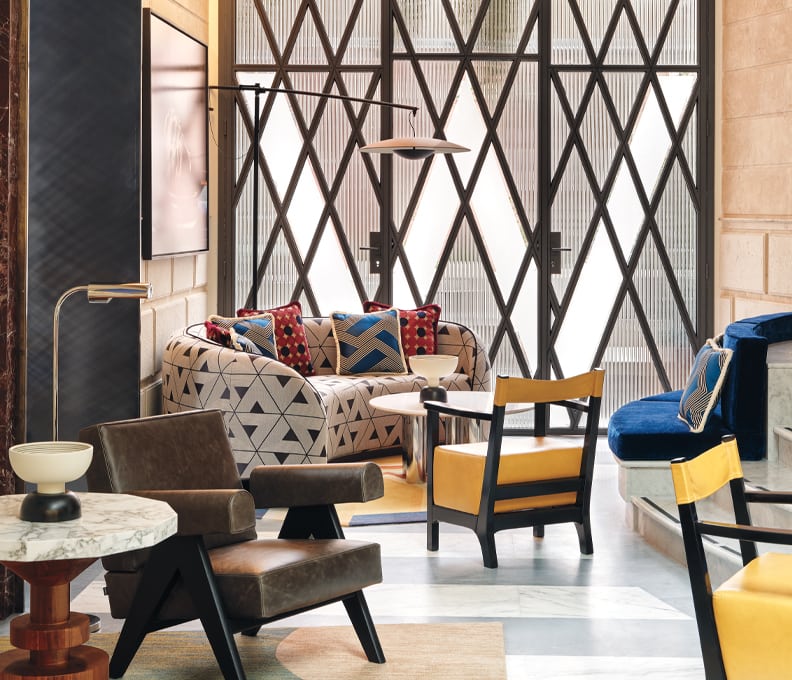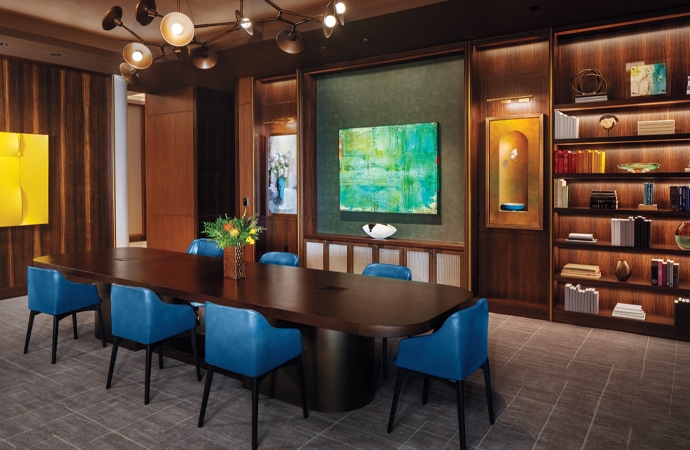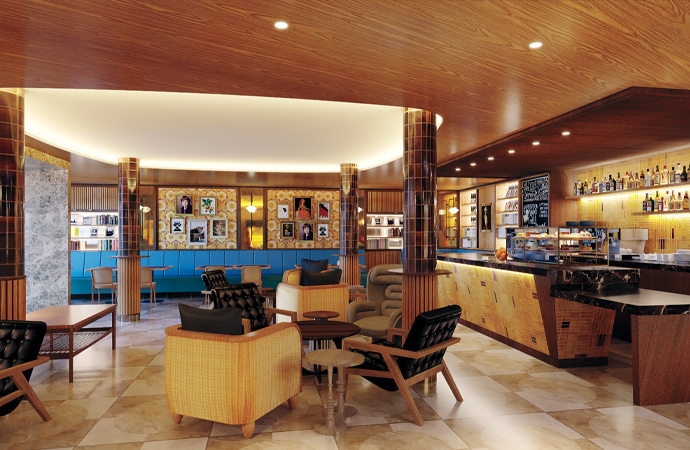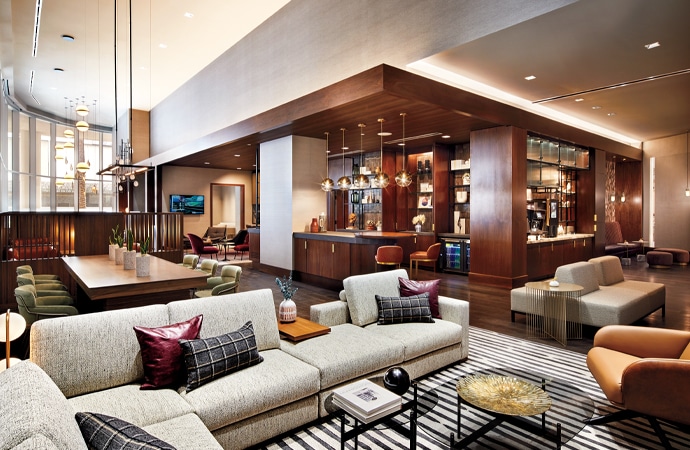The Future of Hotel Common Spaces Is Here
Remote jobs and business-meets-leisure travelers have accelerated the need for functional, convertible spaces
by Todd Plummer
November 7, 2022

Living room at the W Rome / Photo: Courtesy of W Rome
We’ve all been to one: cramped, lifeless, with harsh fluorescent lighting that clicks overhead and some smattering of dowdy, stiff furniture. No, it’s not the morgue—but perhaps not far off. It’s a dreary hotel lobby. For so long, hotels (and especially business hotels) were designed around the central conceit that travelers wanted to check in, go straight to their rooms and be left alone, but the ways we live have changed, as have the ways we work and travel.
Over the last decade, hotels everywhere have been positioning themselves as lifestyle destinations, not only as places to sleep, but also as places to work, eat and drink, and meet. What would the Meatpacking District be without the Gansevoort? Miami Beach without the Fontainebleau? Or L.A. without The Beverly Hills Hotel’s Polo Lounge?
Recent years have only accelerated this trend, with a surge of work-from-anywhere jobs and business-meets-leisure travelers in need of highly functional, convertible spaces. And now a fresh crop of hotels around the world is changing the way common spaces look and feel.
“When we first faced the coronavirus, hotels began to retrofit their reception areas with plexiglass panels, meanwhile rearranging seating to create socially distanced public spaces,” says Jun Chun, principal of Champalimaud Design. But as people became more comfortable with travel, the dividers slowly disappeared, while the new furniture arrangements remained. Chun says there was an understanding that hotel common spaces would become more flexible and public spaces less fixed. “Interior designers need to open up hotel spaces with flexible loop plans and furniture layouts, all of them connecting to create deeper, layered spaces that are not limited to a single function.”
Consider the new Conrad Nashville, one of Chun’s projects. Instead of a traditional business center, the hotel has a “library” complete with lounge seating, integrated charging hubs for devices, a communal table, and a full wall of bookcases. No clicking fluorescent bulbs in sight. The gorgeous space functions as a traditional business center, but is much more flexible, operating as both work space and gathering space.

Library at the Conrad Nashville, Tennessee / Photo: Greg Ceo
The idea of common spaces as somewhere to sit back and spend time is starting to take hold, as well. Consider W Hotels. The brand, long known for its glossy, oversexed, “bottles and models” nightlife-centric ethos, debuted a new design vision this year with the opening of the W Rome, the brand’s first foray into Italy.
W hotels have long espoused a living-room-type lobby, but this new property does away with the dark, the raunchy and the cheeky, instead opting for natural stone and wood finishes, pastel colors and natural light to create spaces as inviting for daytime as they are at night. Stepping into the lobby, where the check-in desks are discreetly hidden in a side room, it feels less like a den of debauchery and more like your most elegant European friend’s living room. Several distinct seating areas encourage guests to pull up a chair and linger, perhaps shooting out a few emails on their phone or perhaps making new friends. The lobby is no longer a place you walk through on your way to the nightclub—it’s a destination in its own right.
But the future of hotel common spaces isn’t just about places that look pretty—they have to perform, as well. At the newest Virgin Hotels location in Glasgow, opening next month, the lobby includes a Commons Club, inspired by the first Virgin Atlantic Clubhouse at Heathrow airport. The “modern-day social club” is an open loft space built for co-working. Instead of relegating meeting and conference rooms to some forgotten corner of the hotel, they’re taking center stage. Several dens with a variety of seating options, including communal tables and comfortable chairs, will accommodate both solo travelers and larger parties of six or more, in a position of prominence entirely visible from the main lobby.

Virgin Hotels Glasgow, Scotland / Photo: Courtesy of Virgin Hotels Glasgow
“Travelers today are not one-note, but rather deeply individual, expressing a variety of preferences and seeking experiences that are more dynamic,” says Teddy Mayer, creative director of Virgin Hotels. Responding to those preferences is a priority for Virgin moving forward. Food and beverage service throughout the Glasgow Commons Club makes ordering a cappuccino for your afternoon meeting, or a cocktail and snacks while you work, a seamless experience—and a smart new revenue stream, whereas stagnant business centers were essentially revenue dead zones.
Sheraton, too, is introducing multifunctional work/play spaces globally. The brand’s new design signatures include community tables anchoring each hotel’s lobby, with built-in lighting and wireless charging stations allowing guests to work, eat and contribute to a lively energy; glass-enclosed gathering spaces called studios that contribute to the energy of public spaces but also provide privacy for meetings; and booths, soundproof spaces strategically placed throughout the lobby so guests can take spontaneous phone calls. These three features will be rolled out across Sheraton properties and have already been installed in 10 percent of the global portfolio, including at the Phoenix Downtown, Denver Downtown, Grand Nashville Downtown and Tel Aviv locations.

Sheraton Club at the Sheraton Phoenix Downtown / Photo: Courtesy of Sheraton Phoenix Downtown
Indeed, the hotels of the future will need to be dynamic spaces. Design, like any aspect of the culture, reflects the times we live in, and the pandemic changed everything—we work from home, we time our meetings to coincide with social plans, and the traditional bounds of “business” and “leisure” are more of a nebulous suggestion than a hard-and-fast divide.
And if you ask me? I’m glad the morgue-like aesthetic is becoming a thing of the past.



